Category: Idaho Army National Guard
Idaho Army National Guard rescues injured hiker near Stanley
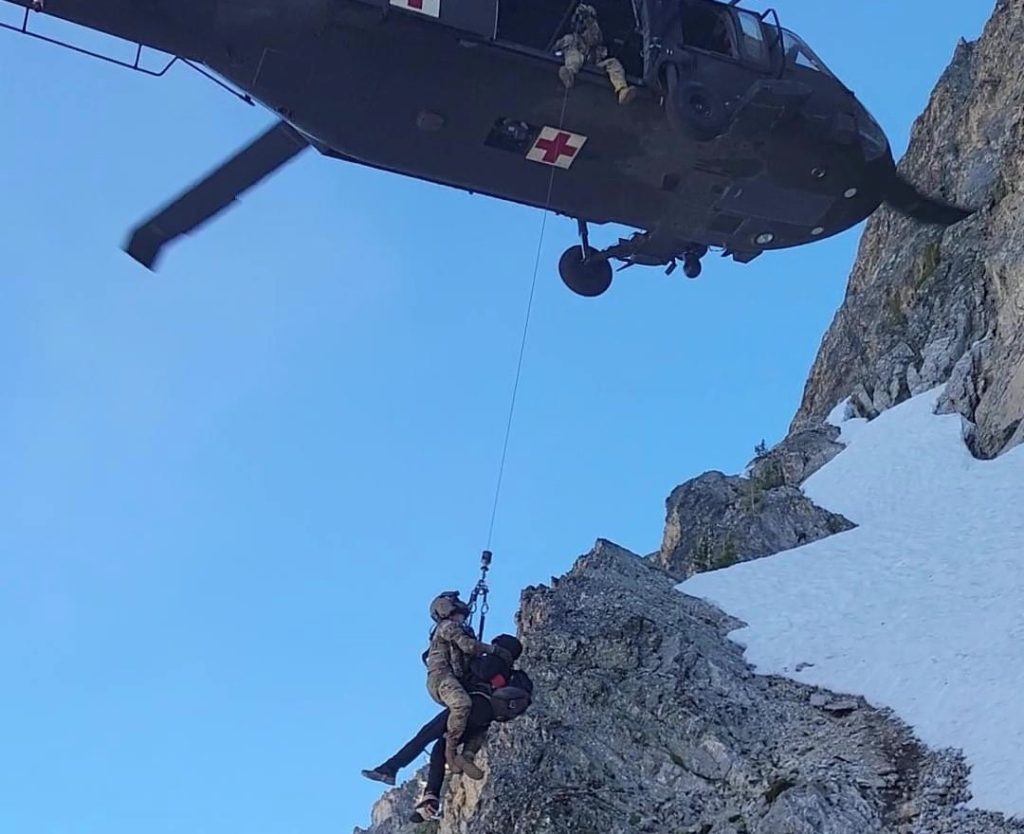
The Idaho Army National Guard’s State Aviation Group assisted Custer County Search and Rescue with the rescue of an injured hiker July 6 on Thompson Peak of the Sawtooth Range, outside of Stanley, Idaho.
The hiker, a 19-year-old male, suffered an ankle injury following a fall while rock-climbing near the mountain range’s highest peak, located approximately 75 miles outside of Boise.
“Our crew did an incredible job under some very challenging environmental conditions,” said Capt. Katherine Smith, commander of Det. 1, Company G 1st of the 168th Aviation Regiment. “The rescue required a great deal of crew coordination, as well as teamwork with the highly proficient extraction team from the Custer County Sheriff’s Office.”
The flight crew consisted of pilots Chief Warrant Officer 3 Theron Cameron and Chief Warrant Officer 3 Brennan Hoover; two crew chiefs, Sgt. Adam Brundy and hoist operator Sgt. Jessica Adamson; and one medic, Sgt. 1st Class Jared Gilstad.
The patient was initially located on a shear rock wall under a ledge. After locating him, crew members determined that there was no way to safely insert a hoist rider and extract him. The flight crew then flew to the Stanley Airport and picked up a five-person technical rope rescue team from Custer County’s search and rescue team.
“We were able to inert the team about 300 meters away from the patient using a two-wheel landing,” said Chief Warrant Officer 3 Theron Cameron, an Idaho Army National Guard UH-60 pilot.
The rescue team roped to the patient and relocated him to more favorable recovery site, where Adamson was able to lower Gilstad safely onto the ground near him. Gilstad quickly secured the patient and Adamson hoisted the pair back into the aircraft while the pilots kept the aircraft stable in challenging conditions.
“Due to the reduced power margins caused by altitude of more than 10,300 feet, the uneven terrain and the location of the extraction site, the aircrew was forced to pay extremely close attention to the aircraft limitations,” said Smith. “Lack of situational awareness in these types of situations could lead to a loss of lift or even rotor drop, requiring the aircrew to have to execute an emergency procedure to maintain stable flight.”
The flight crew transported the patient to the Stanley Airport, where he was transferred to civilian medical care.
State, Guard Conduct Cyber Discovery 2024
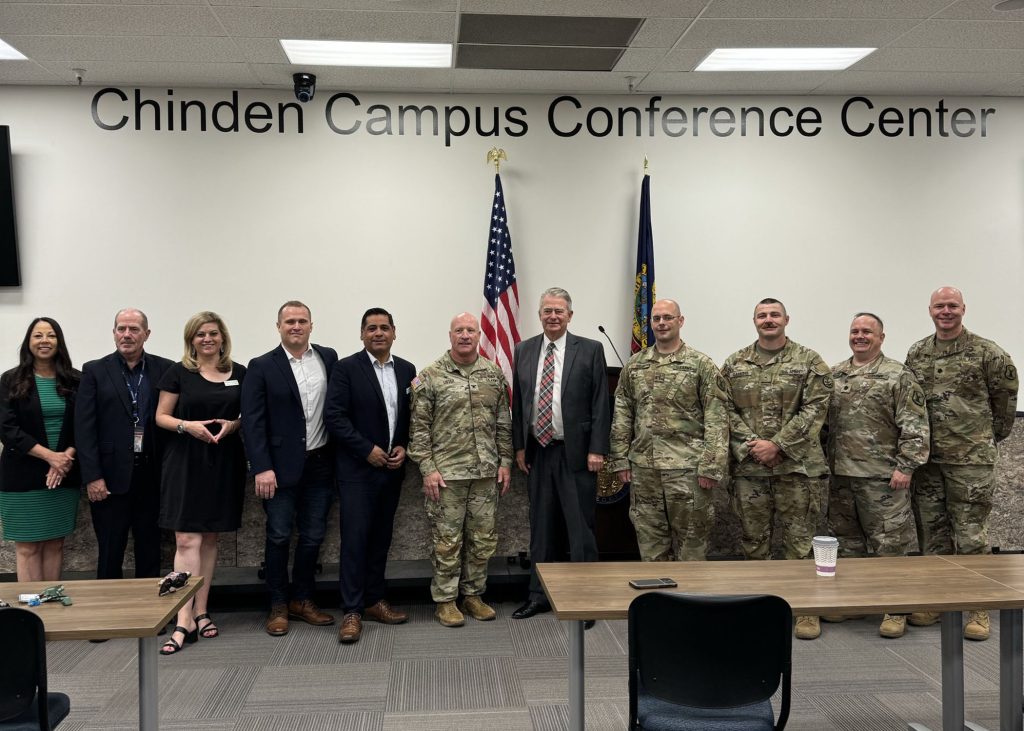
The Idaho National Guard and the Idaho Office of Information Technology Services recently hosted Cyber Discovery 2024 at the state’s Chinden Campus in Boise. Cyber Discovery is a regional cyber exercise focused on security operations, incident tracking and response. The exercise takes place within the framework of the Department of Defense’s Innovative Readiness Training program, enhancing its training value to both the state and Idaho National Guard while saving taxpayer dollars.
“One of the biggest benefits to conducting the training like this is that there’s minimal cost to either party,” said Col. Dan Lister, chief information officer for the Idaho National Guard’s Office of Information Management. “If you were to simulate this, you would be into the millions of dollars.”
During the exercise, 26 Guardsmen from Alaska, Idaho, and South Dakota Army and Air National Guards played the role of cyber threat actors while a team of 19 ITS employees, three Boise State cyber security program students and three Idaho Army National Guardsmen formed a defense team.
“We’re training to rapidly integrate Guard members for that cyber 911 that could come at any time,” said Chief Warrant Officer 4 Jerred Edgar, a defense cyber operations element officer with the Idaho National Guard. “We’re able to use the IRT to form and shape that response and rehearse it with our partners.”
Edgar said the ITS blue team made significant strides in threat detection, synchronized actions, and teamwork over last year’s performance in the exercise.
“Everything we do in these environments produces tangible results that the state can use to reduce cyber threats,” he said. “It’s process improvement, it’s building on efficiencies and identifying effective tools.”
The exercise provides exceptional training value to Guard members as well, said Lister.
“They’re training in a large-scale, real-world environment,” he said. “It really can’t be simulated and it’s very complementary to the skill sets they will use at various military echelon levels wherever they go in the world.”
Maj. Gen. Timothy J. Donnellan becomes Idaho’s 26th adjutant general
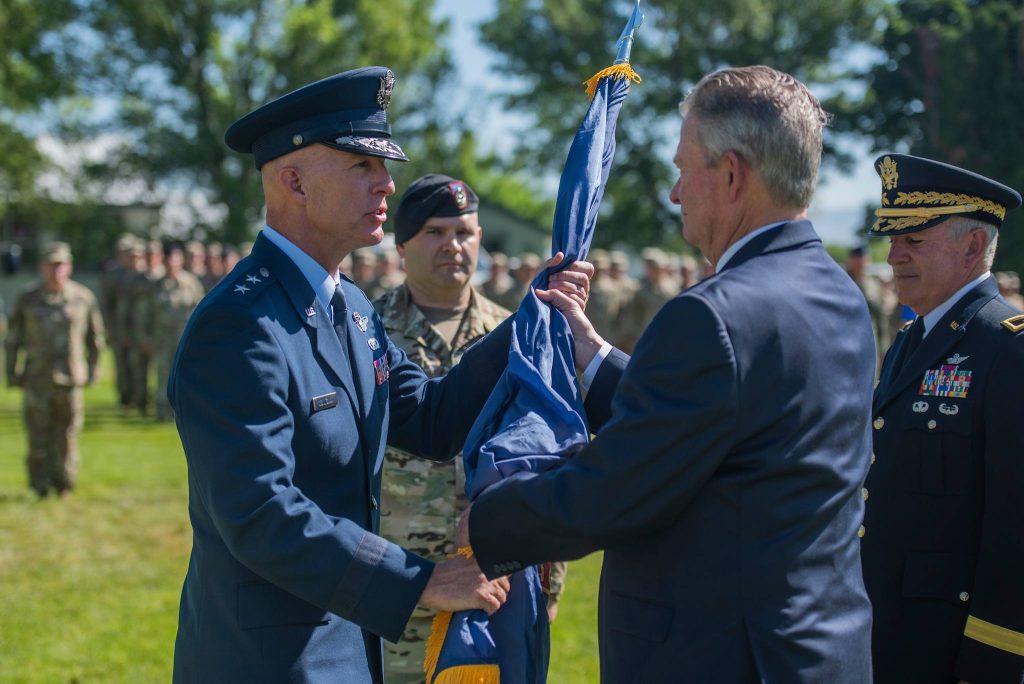
Guardsmen, Volunteers Clean Up Birds of Prey National Conservation Area
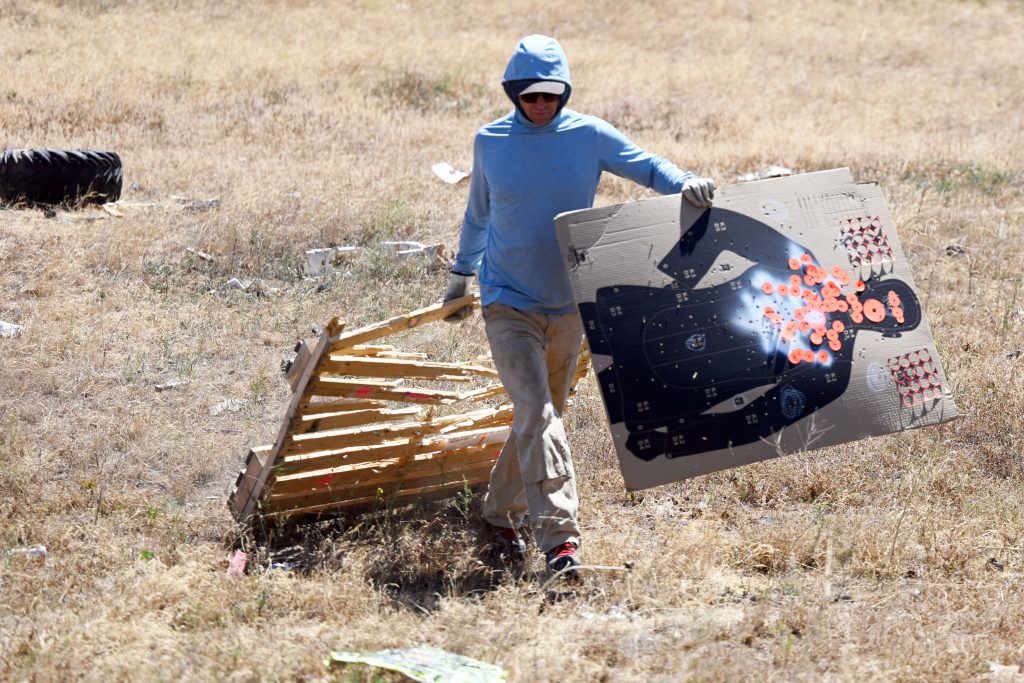
Idaho National Guardsmen, German JTACs reinforce relationships through training
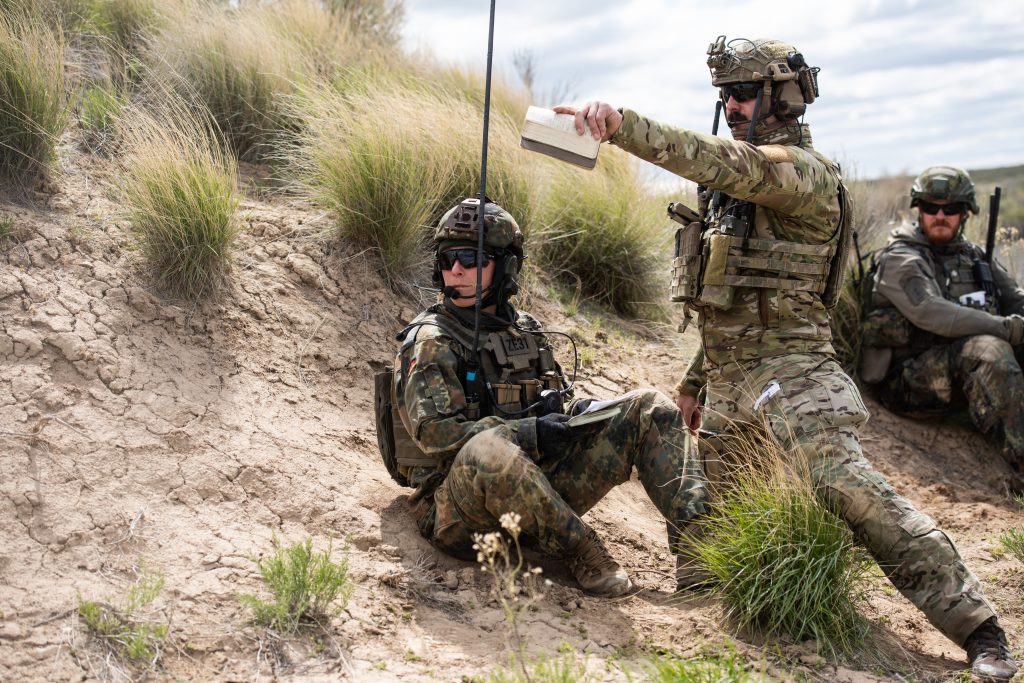
In 2015, an enlisted Idaho Air National Guardsman and a German Army lieutenant attended the same Joint Terminal Attack Controller Qualification Course and began a friendship that has had international implications for the past eight years. The two engaged in a series of conversations throughout their time at the course that resulted in a lasting partnership between the Idaho National Guard and the German military.
Master Sgt. Justin Clark, a senior airman at the time, is now a JTAC program coordinator with the 124th Air Support Operations Squadron. Clark said he immediately began looking for opportunities to bring the lieutenant’s unit to Idaho upon his return from the course. He said his unit commander’s support was key to guiding him through the process of coordinating and facilitating the German JTAC unit’s first visit to Gowen Field in the spring of 2016. The unit has returned every year since.
“The win, where it gets better every year, is the partnership,” said Clark. “We share lessons learned, and everyone’s experience culminates to make both parties better.”
This year, soldiers and airmen from Germany’s Joint Terminal Attack Controller Competence Center partnered with the Idaho Air National Guard’s 124th Fighter Wing to conduct close air support training at the Saylor Creek and Juniper Butte Ranges, Idaho, May 1-18. Idaho Army National Guard UH-60 pilots and crew also supported portions of the training, adding another layer of realism to the German troops training and further expanding their nearly decade-long partnership. The joint training incorporated NATO tactics, techniques and procedures, utilizing A-10 Thunderbolt II aircraft to prosecute targets ranging from armor, artillery, bunkers, simulated enemy combatants, moving targets, surface to air threats and more.
The visiting joint terminal attack controllers coordinate, integrate and direct the actions of combat aircraft engaging in close air support operations and joint fire observers, who augment JTACs by relaying target data. Leading them was Clark’s former classmate, Maj. Andreas Marx. Now a JTAC instructor himself, he said taking advantage of Idaho’s vast military range complex to enhance his unit’s training and further strengthen the international partnership is a win-win partnership.
“The CAS training opportunity that we have here, in conjunction with our partners from the 124th Fighter Wing is invaluable to us,” Marx said. “We do focus our training very much on large scale combat operations scenarios in the European theater of operations. Our partnership provides both sides with a common understanding and shared TTPs that will be of utmost importance during possible future conflicts with near-peer enemies.”
Located approximately 43 miles southeast of Gowen Field, Saylor Creek Range offers an impact area three miles wide by six miles long, where air and ground assets can employ live munitions.The Juniper Butte Range is located on 110,000 acres in southern Idaho and is covered with simulated hostile radar facilities, most of which are moveable electronic “threats. The range complex consists of two mock surface to air missile site targets in two strafe pits, a command site, a mock rail yard protected by two SAM sites, a radar/radio jamming tower and a range maintenance depot.
Master Sgt. Dennis Goettel, a joint fires platoon sergeant with the German Army, said the training site is unlike anything they have in Germany.
“In Germany, our soldiers never get into realistic situations like they do in Idaho because of training restrictions,” said the platoon sergeant. “It helps our soldiers to see live munitions hit their targets because then they know what they say to pilots really matters.”
In addition to the training, 124th ASOS Airmen and their German guests participate in other military exchange activities. This year, the units completed German and ASOS physical fitness assessments, and the Germans conducted shoot-and-move 9mm pistol and M4 carbine qualification courses for the Guardsmen.
Clark said the unit is expected to return to Gowen Field for another training event in August, when it will fully integrate with the 124th ASOS to conduct full mission profiles encompassing the squadron’s focus points – shoot, move, communicate, practice combat medicine and fitness.
Air Force’s 582nd Helicopter Group trains at OCTC
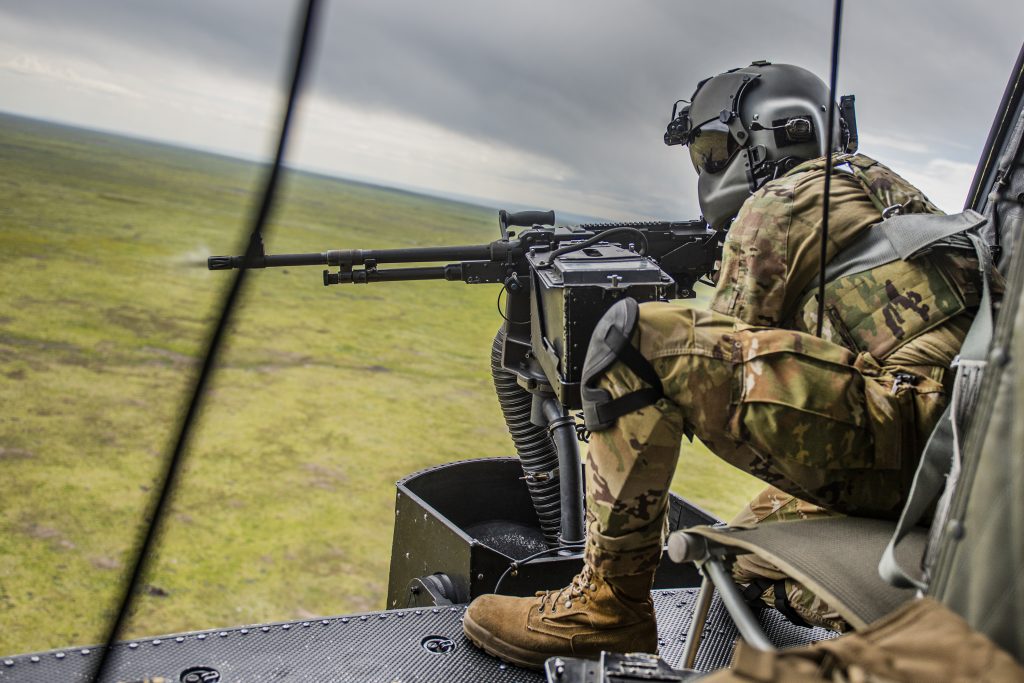
The Air Force’s 582nd Helicopter Group, conducted aerial gunnery training at the Orchard Combat Training Center April 15-26 to ensure its pilots and flight engineers are ready and able to provide airborne security operations.
The squadron, headquartered at F.E. Warren Air Force Base in Cheyenne, Wyoming, is geographically separated with squadrons in Montana, North Dakota and Wyoming, Its members fly security response missions, enabling key Task Force 214 operations supporting nuclear security missions for 450 intercontinental ballistic missile sites throughout the region.
The training, which incorporated elements from all three states, serves a dual purpose, said Air Force Capt. Nick Curren, a UH-1N Huey pilot and mission commander for the training evolution. Flight engineers are focused on conducting pre-flight weapons checks, remediating weapons malfunctions and engaging targets on the range, while pilots are focused on maneuvering the aircraft to maximize engineers’ opportunities for success. The end result should be a tighter, more proficient crew.
Curren, along with many of his fellow Airmen, is training at the OCTC for the first time. Most of the squadron’s similar training exercises take place at bases in Canada, Minnesota, Utah and Wyoming, but the OCTC’s reputation and amenities made the decision to train in Idaho an easy one, he said.
“We’ve only ever heard good things about the range,” said Curren. “This is also my first time as a mission commander, and the people here have been great about answering all my questions and helping me make sure we are doing everything we need to do to make this a success.”
Idaho’s OCTC is a premier joint combined arms training site with 171,000 acres and 23 world-class ranges.
Youth ChalleNGe Academy breaks ground on new barracks

The Idaho Youth Challenge Academy broke ground on a new barracks building April 9 in Pierce. Representatives from the Idaho National Guard gathered for the ceremony along with staff members from Gov. Brad Little’s office.
The $13.5 million, 18,000 square foot building will replace temporary billeting facilities currently in use at the academy. The new barracks also allows for potential expansion of the program with room to house up to 180 students and cadre.
Academy Director Trevor Sparrow said building strong relationships has been an important aspect of its success and growth over the years.
“We are so grateful for the support of all of our partners around the state from the cadets who attend, their families, local businesses and communities, the Idaho State Legislature and the Governor’s office,” said Sparrow. “This building solidifies the commitment that Idaho has to ensure the Idaho Youth ChalleNGe Academy stands ready to ensure a legacy of excellence for decades to come.”
The Idaho Youth ChalleNGe Academy opened its doors in 2014 with the mission “to intervene in and reclaim the lives of at-risk youth to produce program graduates with the values, skills, education and self-disciple necessary to succeed as responsible and productive citizens and adults.” Since then, the academy’s focus on providing education and developing employment and life skills among its student body has helped more than 2,000 Idaho youth earn traditional or general education diplomas.
Maj. Gen. Michael Garshak, Idaho adjutant general and commander of the Idaho National Guard, served as the presiding official during the ceremony.
“Two thousand and seventy-five young men and women from the state of Idaho have completed this and have really improved the citizenship and the future for our state,” said Garshak. “It’s time now that we move out of a temporary facility and build permanent barracks because I think the Youth ChalleNGe Academy has demonstrated that it is here to stay.”
The project is slated to be completed in November 2025.
Bolt assumes command of Alpha Company ‘Animals’
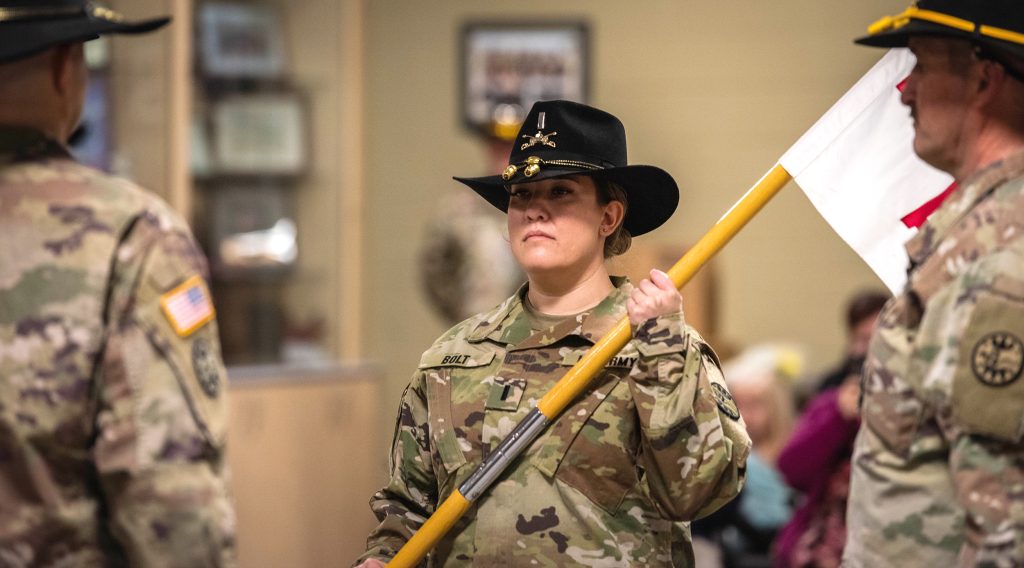
1st Lt. Lauren Bolt became the first female Idaho National Guard Soldier to command a line unit in the 116th Cavalry Brigade Combat Team when she took her post as the commanding officer of Company A, 2-116th Combined Arms Battalion during a Feb. 26 change of command ceremony at the unit’s headquarters in Emmett, Idaho. The 2-116th is headquartered in Caldwell with units in Emmett and Nampa.
“I’m excited to be joining Alpha Company as their new commander,” said Bolt. “For the rest of this year, we have a lot to accomplish. However, I have nothing but trust, faith and confidence in the team that Capt. Edwards and 1st Sgt. Taft Bearden have built.”
Bolt, who has since been promoted to captain, relieved Capt. Arthur Edwards, who has led the unit since August 2020. Bolt enlisted in the Nevada National Guard in 2015 and initially served as a motor transport operator. She was commissioned in May 2017 as an armor officer through the University of Nevada, Las Vegas ROTC program and began her career with the Idaho National Guard as a platoon leader for Company B, 2-116th CAB. In 2019, then 2nd Lt. Bolt made Idaho history when she and fellow 2nd Lt. Brooke Berard graduated from the U.S. Army’s Armor Basic Officer Leaders Course as the state’s first two female armor officers. She has since served as the executive officer of both Company B and Headquarters and Headquarters Company. In Bolt’s most recent post she served as the battalion’s maintenance officer during its deployment in support of Operation Spartan Shield.
“I am confident in her ability to continue the Animal Company’s legacy of mission success.,” said Lt. Col. Barrett Bishop, 2-116th CAB commanding officer. “I was the battalion executive officer when Lauren was a new platoon leader, and she has developed herself well in Army competence and personal tact.”
The Army opened combat arms jobs to female Soldiers in 2015. Over the past decade, Idaho National Guardsmen have transitioned into career fields not previously open to them or reached new heights in their fields while continuing to ensure the organization remains “Always Ready, Always There” to respond to emergencies at home and abroad.
In 2014, Maj. Kimberly Tschepen became the state’s first female Soldier to command a battalion when she took command of the 145th Brigade Support Battalion and Command Sgt. Maj. Linda Burkhart became the state’s first female command sergeant major in 2015.
In 2015, Idaho Guardsman 1st Sgt. Erin Smith became the first female enlisted Soldier in the nation to graduate from M1 Armor Crewman School. Following her, Staff Sgt. Kylene Huerta completed the same course and became the first female Soldier to be assigned to the 116th CBCT as a tank crew member.
In 2017, Sgt. 1st Class Melanie Galletti graduated from the U.S. Army’s Infantryman Course as the Idaho National Guard’s first qualified female enlisted infantry Soldier. That same year, Col. Lora Rainey was appointed as the state’s first female staff judge advocate.
In 2019, 2nd Lt. Jessica Pauley became the state’s first female infantry officer.
Edwards’ departing remarks focused on reminding Company A Soldiers of their accomplishments and the pride he felt as their commander over the past two years.
“From day one, I have been beyond impressed with the professionalism and dedication of Alpha Company Soldiers,” said Edwards. “We have supported local and national callings, all while being part of an all-volunteer force … and I could not be prouder of serving alongside those volunteers.”
Total Force: Army, Air, Navy train together in mass casualty combat exercise
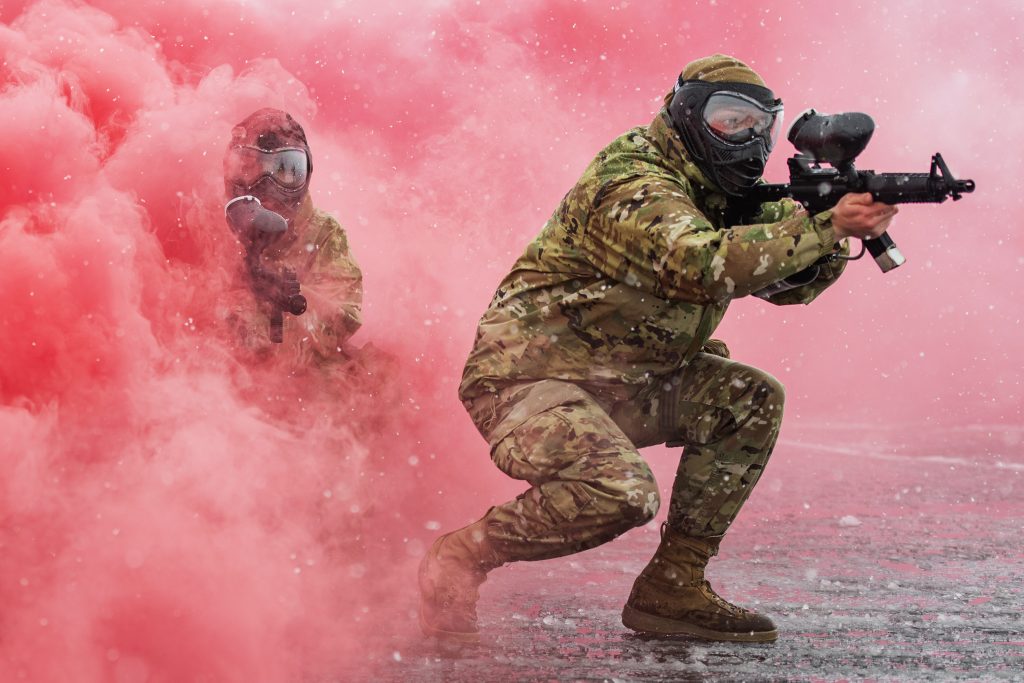
Master Sgt. Becky Vanshur/Idaho Military Division Public Affairs
BOISE, Idaho – A deep breath in, deep breath out. An Airman from the Idaho Air National Guard holds his weapon steady in front of him, pressing it against his shoulder, finger on the trigger, his body low to the ground. He takes a small, strategic step into the plume of smoke swirling around him. Surrounded by a blanket of red smoke makes it hard to see his battle buddy but he knows his counterpart, a Soldier from the Idaho Army National Guard’s Medical Detachment, is close behind him.
The red smoke is used to conceal the medical team’s movements as they defend their medical structures and personnel who are being ambushed while conducting Tactical Combat Casualty Care on the battlefield. The two Guardsmen were among approximately 200 Idaho National Guard Soldiers, Airmen and their active duty and Navy Reserve counterparts who joined forces for a mass casualty combat exercise, Feb. 1-4, near Gowen Field.
“The main focus of this joint services training was to all come together, learn each other’s jobs and create multi-capable Soldiers, Airmen and Sailors on top of learning how to respond in mass casualty scenarios,” said Senior Master Sgt. Davis Nguyen, the 124th Medical Group function area manager. “Equally important, was the ability to perform medical care while under mental and physical stress.”
The Idaho Air National Guard’s Critical Care Air Transport Team, the ground surgical team and other medical personnel from the 124th Medical Group conducted the exercise with the Idaho Army National Guard’s Charlie Company, 145th Brigade Support Battalion Medical Detachment and medevac Soldiers from the 1st of the 168th Aviation Regiment; the Navy Operational Support Center; and active duty Airmen with the 366th Medical Group from Mountain Home Air Force Base.
During the exercise, Soldiers, Airmen and Sailors learned each other’s roles on the battlefield and in the sky. The Idaho Army National Guard’s State Aviation Group incorporated UH-60 Black Hawk helicopters and pilots who responded to 9-Line medevac requests, transporting critical care patients with CCATT officers and medevac Soldiers who stabilized them onboard while flying through simulated combat zones until they reached a higher echelon of care.
“All of our pilots need to practice this piece of the exercise and learn how to fly with patients in the back,” said Chief Warrant Officer 3 Theron Cameron, instructor pilot and medical evacuation officer from the 168th Aviation Regiment. “We need to learn the CCATT’s language to know if they are in the middle of performing a procedure as it cues us to fly as smoothly as possible through the combat areas, while communicating back that we may need to aggressively maneuver around danger.”
Airmen from the 124th Fighter Wing’s Security Forces provided combat lessons on defense and protection, 360-degree security, care under fire and tactical movements with red smoke concealment.
Colin Yates, an Idaho Peace Officers Standards and Training instructor specializing in wounds and trauma for tactical medicine, created realistic wounds on 124th Fighter Wing’s Student Flight role players acting as casualties for a more real-world training experience of TCCC on the battlefield.
Sailors from the NOSC provided the medical logistics support for the simulated deployment location, while learning from both Army and Air medics on tactical field care, casualty evacuation and Roles 1-4 medical care facilities.
“It’s anticipated in future conflicts, there will be a lot more integration with forces. We need to interact with each other and speak each other’s languages,” said Maj. Mark Urban, CCATT physician. “This exercise was developed with that in mind, being able to integrate is really key to that Total Force concept.”
F-16 mission may be coming to Gowen starting in 2027
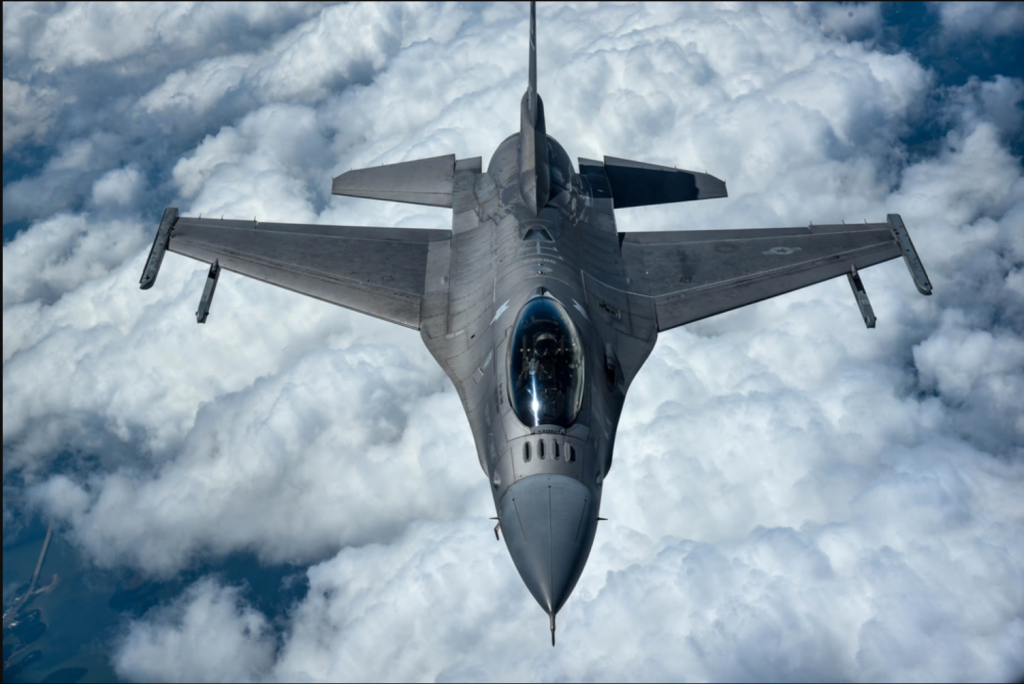
Photo by Tech. Sgt. Teri Eicher , 134th Air Refueling Wing
Gov. Brad Little and members of Idaho’s congressional delegation are proud to announce that the U.S. Air Force has identified the Idaho Air National Guard’s 124th Fighter Wing to potentially receive an F-16 Fighting Falcon mission at Gowen Field in Boise, Idaho.
F-16s are expected to begin arriving at Gowen Field in 2027.
“Idaho is proud of the critical role we have long played in supporting the nation’s defense strategy through the valuable work of the men and women serving at Gowen Field,” Gov. Little said. “The transition to the sophisticated F-16 mission at Gowen Field is the next step in the Idaho Air National Guard’s enduring commitment to safeguarding the liberties and freedoms we hold dear as Americans. This is an exciting step that will benefit the State of Idaho and the United States of America.”
The Idaho Air National Guard has maintained a fighter mission at Gowen Field for more than 75 years. This transition would replace the 18 A-10 Thunderbolt IIs that have been in service at Gowen Field since 1996. The one-for-one exchange would include the same number of F-16s, which are a more advanced and combat-effective aircraft.
The Air Force has planned to divest its aging A-10 inventory for more than a decade. Discussions have been ongoing among Idaho National Guard leaders, and local, state, and federal officials since 2012. Then, the Idaho Air National Guard was notified that their A-10 fleet was identified for divestment by 2015. However, events in Southwest Asia at the time extended the aircraft’s relevance just as the 124th FW embarked on the largest deployment in its history the following year. The 124th FW deployed again in 2020 marking its second largest deployment.
This modernization will better align the Air Force to support the current National Defense Strategy by leveraging the 124th FW’s existing fighter aircraft operations and maintenance expertise once the A-10s at Gowen Field are retired, beginning in the fall of 2026.
“Deterrence is a critical aspect of the National Defense Strategy,” said Brig. Gen. Tim Donnellan, commander of the Idaho Air National Guard. “Today’s near-peer adversaries like Russia and China remind us it’s imperative to ensure our personnel are trained and proficient with the best equipment and tools necessary to fight and win our nation’s wars.”
The Idaho National Guard expects a more detailed timeline from the Air Force in the coming months that will outline the next steps, such as the completion of an environmental impact analysis, planned for the spring of 2025.
The Idaho Air National Guard has been a fixture of the community since 1946. Since then, Idaho National Guard pilots have transitioned through 9 different types of fighter aircraft. With each new aircraft, the organization modifies its noise abatement procedures to minimize the impacts of jet noise on the community.
“Idaho National Guardsmen are rooted in every community in the state,” said Maj. Gen. Michael Garshak, adjutant general of Idaho. “When we are called upon, it’s your friends, families and neighbors coming together to support our community and our nation. Being good stewards of our environment is a priority and we will ensure Boise continues to be one of the most livable cities in the country, regardless of the aircraft we operate.”
Monday’s announcement from the Secretary of the Air Force would mean the continued viability of the Idaho National Guard. With more than $650 million dollars in annual economic impact coupled with nearly 8,000 jobs the Idaho National Guard creates, securing a follow-on fighter mission is a critical part of ensuring Idaho’s prosperity.
 Official Government Website
Official Government Website